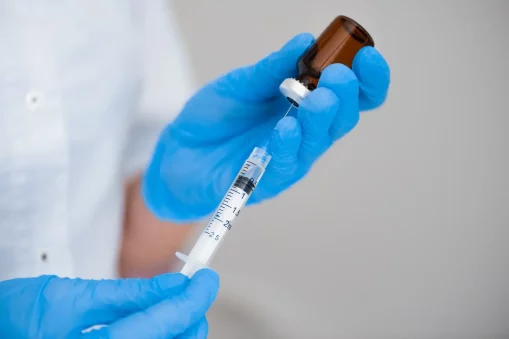From its first use, until today, botulinum toxin has had a huge impact on modern medicine. Originally famous for its ability to block neuromuscular transmission, today we use it for so many things — from treating cervical dystonia and chronic migraines to refining facial aesthetics with wrinkle reduction.
That widespread popularity has led to many manufacturers appearing on the market and obviously not all botulinum toxin brands are the same. Differences in formulation, protein load, diffusion properties, onset time, longevity, and other features can significantly impact results.
That’s why we decided to single out five leading botulinum toxin brands, plus compare the most important characteristics to help you make easier decisions for your clients.
The 5 Best Botulinum Toxin Brands
It’s time to break down the top five botulinum toxin brands and help every medical professional and aesthetic practitioner.
Botox® (OnabotulinumtoxinA)
As the industry leader, Botox® has been the most extensively studied and widely used botulinum toxin product since its initial FDA approval in 1989. It has been approved for over 10 medical conditions in addition to its cosmetic applications.
Key Features & Applications
- Medical: Chronic migraines, overactive bladder, spasticity, cervical dystonia, strabismus, hyperhidrosis.
- Aesthetic: Forehead lines, glabellar lines, crow’s feet, masseter reduction.
Efficacy & Safety
- Onset: 3-5 days
- Duration: 3-4 months
- Clinical trials confirm high safety standards, with an adverse event rate of <1% when administered correctly.
Cost & Market Position
Botox® is a premium product due to its reputation and global regulatory approvals. Its higher price reflects its dominance in both the medical and cosmetic world.
Dysport® (AbobotulinumtoxinA)
Dysport® is widely recognized for its faster onset and broader diffusion. Its ability to spread more easily than Botox® can be both an advantage and a challenge.
Key Features & Applications
- Medical: Upper limb spasticity, cervical dystonia.
- Aesthetic: Frown lines, forehead wrinkles, excessive sweating, marionette lines.
Efficacy & Safety
- Onset: 24-48 hours, often faster than Botox®.
- Duration: 3-4 months.
- Due to its higher diffusion rate, precise injection technique is crucial to avoid unintended muscle relaxation.
Cost & Market Position
Dysport is generally more affordable than Botox®, offering a cost-effective alternative, particularly for treatments requiring a larger injection area. Many practitioners opt for Dysport® when treating foreheads or masseter muscles.
Xeomin® (IncobotulinumtoxinA)
Xeomin® is the only botulinum toxin that is free from complexing proteins, meaning it contains only the active neurotoxin. This “naked” formulation reduces the risk of antibody resistance. Because of its pure composition, Xeomin® requires no refrigeration before use. Good thing for all medical facilities, right?
Key Features & Applications
- Medical: Blepharospasm, cervical dystonia.
- Aesthetic: Facial lines, masseter hypertrophy.
Efficacy & Safety
- Onset: 3-4 days.
- Duration: 3-4 months.
- Clinical studies confirm its efficacy matches Botox, with a lower risk of immunogenic resistance.
Cost & Market Position
Xeomin® is competitively priced, a bit cheaper (or cost-effective) alternative to Botox. It is especially beneficial for patients who have developed resistance to other botulinum toxin products.
Jeuveau® (PrabotulinumtoxinA-xvfs)
Jeuveau® is marketed as “Newtox”, a modern alternative to Botox specifically designed for aesthetic applications. Unlike Botox®, it is not approved for medical treatments, so Evolus focuses exclusively on the cosmetic market.
Key Features & Applications
- Medical: Not FDA-approved for therapeutic indications.
- Aesthetic: Glabellar lines, forehead lines, periorbital wrinkles.
Efficacy & Safety
- Onset: 2-3 days, slightly quicker than Botox®.
- Duration: 3-4 months.
- Performance is near-identical to Botox.
Cost & Market Position
Jeuveau is typically 15-25% cheaper than Botox, giving you the chance to provide affordable neurotoxin treatments without compromising on quality. Since it is only approved for cosmetic use, it is often used by beauty and dermatology clinics but not medical institutions.
Letybo® (Botulax)
Letybo® has long been a leading botulinum toxin in South Korea, recently getting more and more popularity in international markets due to its cost-effectiveness and fast-acting results. It remains primarily known in Asia, but it’s entering the U.S. and European markets, too.
Key Features & Applications
- Aesthetic: FDA-approved for glabellar lines.
- Medical: Still under clinical evaluation for broader indications.
Efficacy & Safety
- Onset: 2-3 days.
- Duration: 3-4 months.
- Studies indicate comparable efficacy to established brands.
Cost & Market Position
Letybo® is up to 30% cheaper than Botox. It does not yet have the same global recognition or extensive clinical history as Botox® or Dysport®, but it is the perfect lower-cost alternative.
Criteria for Evaluating Botulinum Toxin Brands
Selecting a botulinum toxin product is not a one-size-fits-all decision. The following factors influence clinical choice:
- Efficacy and Purity: The effectiveness of a botulinum toxin formulation depends on its biological activity, protein content, and stabilization method. Purity levels also play a role in minimizing the risk of antibody formation, which can lead to treatment resistance.
- Safety Profile: Botulinum toxin injections are generally safe under controlled administration, yet differences in manufacturing processes can affect adverse event rates. Common side effects include localized swelling, bruising, and transient muscle weakness, but systemic diffusion, ptosis, or dysphagia can occur with improper dosing or technique.
- Onset and Duration of Results: Speed of action varies between brands, with some offering noticeable effects within 24-48 hours and others taking 4-7 days. Similarly, longevity varies between 3 to 6 months, depending on formulation and patient metabolism.
- Cost Considerations: Pricing is a crucial factor for both healthcare providers and patients. Some brands offer more cost-effective solutions without compromising efficacy, while premium brands often justify their prices with extensive clinical research and regulatory approval history.
- Availability and Regulatory Approvals: Regional approvals by authorities such as the FDA (U.S.), EMA (Europe), MFDS (South Korea), and CFDA (China) determine accessibility. Some brands are globally recognized, others are restricted to specific markets. Beyond approvals, supply chain stability and distribution networks also impact availability.
How to Choose the Right Botulinum Toxin?
We already talked about numerous factors and criteria for choosing the right product.
Selecting the appropriate botulinum toxin brand requires a thorough assessment of multiple factors. In most cases, you have to start from whether the botulinum toxin will be used for medical or aesthetic purposes. Many brands have approvals for both, but specific formulations may be better suited for certain conditions:
- Aesthetic Uses: Botox®, Dysport®, and Jeuveau® are commonly used for treating dynamic wrinkles. Dysport® may be preferred for larger treatment areas, and Xeomin® is ideal for patients concerned about antibody resistance.
- Medical Uses: Some botulinum toxin brands are specifically used for therapeutic applications, including chronic migraines, cervical dystonia, muscle spasticity, hyperhidrosis (excessive sweating), and temporomandibular joint (TMJ) disorders. Botox® has the broadest range of medical approvals, while Dysport® and Xeomin® also hold FDA and EMA indications for certain conditions.
For medical use, factors such as dosage, frequency, and insurance coverage may further influence brand selection. Some insurers only cover specific brands for medical conditions.
After that, talk with patients about their medical history and whether he has already used similar products. Patients new to botulinum toxin treatments typically respond well to any brand. If a patient has developed resistance, a switch to a highly purified formulation like Xeomin®, may restore efficacy.
Allergy and sensitivity history should also be considered, as some formulations contain stabilizers such as human serum albumin or lactose, which could cause rare but notable reactions.
Conclusion
The botulinum toxin market has evolved significantly and today we have numerous formulations. They can even improve the quality of life.
Botox remains the gold standard with its long-established reputation, yet newer alternatives like Dysport®, Xeomin®, Jeuveau®, and Daxxify® provide unique benefits. We must take advantage of those benefits as well in order to give clients better price, diffusion, or something else that they need.
In general, selecting the right botulinum toxin brand depends on treatment goals, patient history, budget constraints, and regulatory approvals, so always consider those factors before making a final decision.
As the demand for non-invasive aesthetic and therapeutic botulinum toxin treatments continues to grow, we must always stay informed about new products, of which there will be more and more in the coming years.
Frequently Asked Questions (FAQs)
How does the dilution process differ among various botulinum toxin brands?
Dilution is a critical step in botulinum toxin preparation, and each brand has specific guidelines on how much saline should be added. For example, Dysport® requires a different dilution ratio than Botox®, which means dose conversions are necessary when switching between brands. Incorrect dilution impacts diffusion, potency, and effectiveness.
Are there any differences in refrigeration and storage requirements for different botulinum toxin products?
Yes, storage conditions vary between brands and can impact the toxin’s stability. Most require refrigeration at 35-46°F (2-8°C) before reconstitution, while some, like Xeomin®, can be stored at room temperature before mixing. Always check the manufacturer’s suggestions.
What role do carrier proteins play in different botulinum toxin formulations?
Carrier proteins stabilize the toxin but can also trigger immune responses in some patients. Botox® and Dysport® contain accessory proteins that may contribute to antibody formation over repeated use. Xeomin®, in contrast, is a pure neurotoxin without carrier proteins, so the likelihood of immune-related resistance is very low.
How do injection techniques vary depending on the botulinum toxin brand used?
Injection depth, dose, and placement differ based on the brand’s diffusion rate and potency. Dysport spreads more widely, often requiring fewer injection points for larger areas. Botox® and Xeomin® have more localized effects, requiring precise placement to avoid unintended muscle relaxation.
References
Dressler D. Routine use of Xeomin in patients previously treated with Botox: long term results. Eur J Neurol. 2009 Dec;16 Suppl 2:2-5. doi: 10.1111/j.1468-1331.2009.02877.x. PMID: 20002739.
Meretsky CR, Umali JP, Schiuma AT. A Systematic Review and Comparative Analysis of Botox Treatment in Aesthetic and Therapeutic Applications: Advantages, Disadvantages, and Patient Outcomes. Cureus. 2024 Aug 27;16(8):e67961. doi: 10.7759/cureus.67961. PMID: 39328645; PMCID: PMC11427080.
Mueller DS, Prinz V, Adelglass J, Cox SE, Gold MH, Kaufman-Janette J, Nestor MS, Taylor S, Frank K. Efficacy and Safety of Letibotulinumtoxin A in the Treatment of Glabellar Lines: A Randomized, Double-Blind, Multicenter, Placebo-Controlled Phase 3 Study. Aesthet Surg J. 2022 May 18;42(6):677-688. doi: 10.1093/asj/sjac019. PMID: 35092418.
Gostimir M, Liou V, Yoon MK. Safety of Botulinum Toxin A Injections for Facial Rejuvenation: A Meta-Analysis of 9,669 Patients. Ophthalmic Plast Reconstr Surg. 2023 Jan-Feb 01;39(1):13-25. doi: 10.1097/IOP.0000000000002169. Epub 2022 Mar 30. PMID: 35353777.



0 Comments